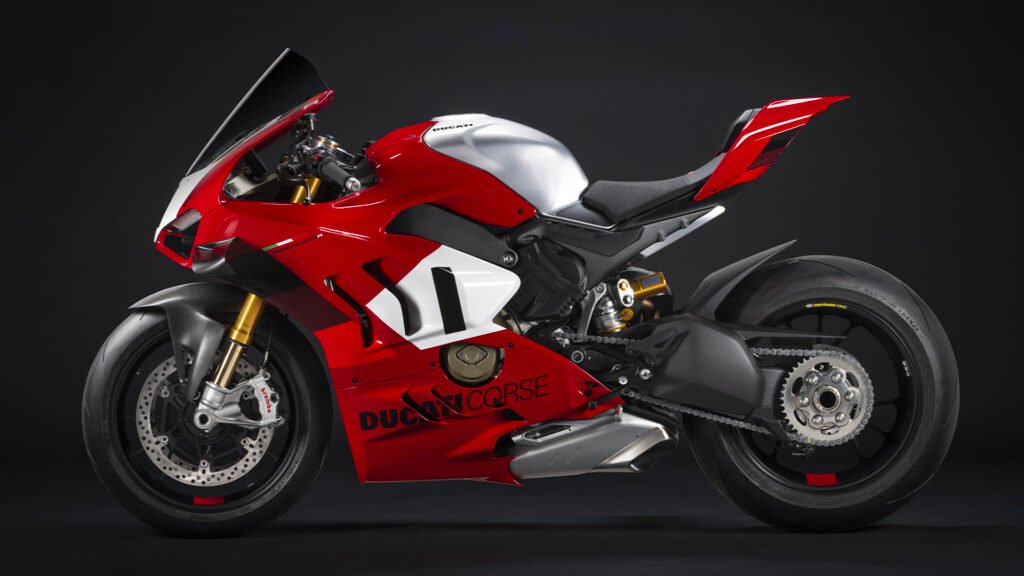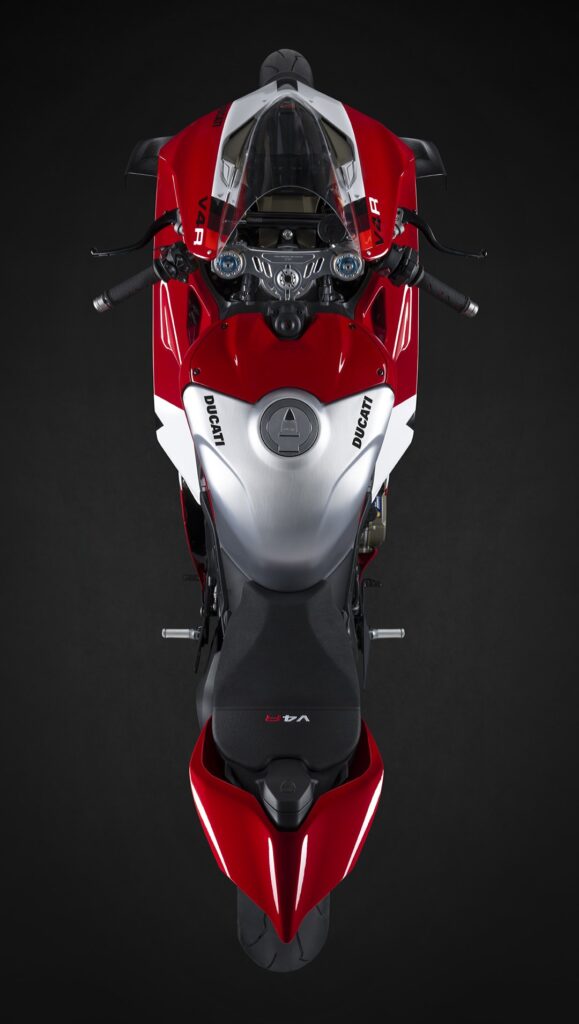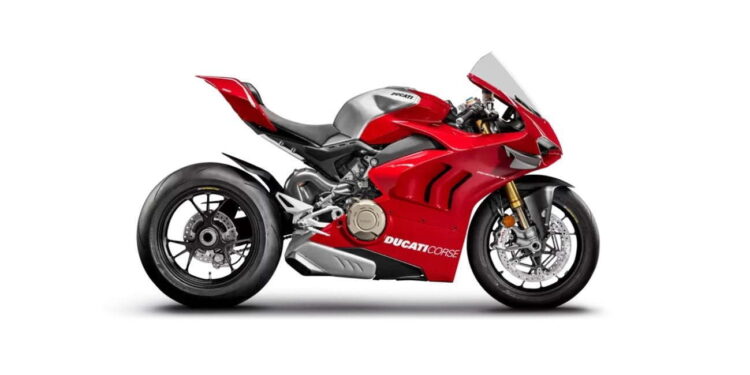Ducati Panigale V4R Acceleration Times
Ducati Panigale V4R top speed and acceleration data through the gears accompanied with Dyno curve and thrust curve graphs.
For many years now Ducati has had an ‘R’ version of their flagship Superbike.
The R is a homologated version of their current Superbike. In the past, we’ve seen many Ducatis with the R extension, including the Panigale 1199R, 1098R, 999R and many more.
Homogolating a special version of the existing Superbike allows manufacturers to qualify a more expensive and competitive Superbike specifically for World Superbike Racing.
The standard Panigale V4 does not meet Superbike class regulations due to the 1103 cc engine being too large, so Ducati put together a very special 998 cc V4 Engine just for Superbike racing.

Ducati Panigale V4R Dyno Curve
In short, Ducati took shrunk the V4 engine by shortening the stroke from 53.5 mm to 48.4 mm, making an already very short-stroke engine even more over-square.
The 998 cc Ducati Panigale V4R is the most powerful and high-revving normally aspirated production motorcycle engine ever released.
Ducati claims 221 horsepower at 15,250 rpm and 83 ft/lb at 11,500 rpm.
With the optional Ducati race kit claimed power is upward of 237 horsepower.
That’s an astonishing 237 horsepower per litre which was unheard of until now. That’s higher than a Yamaha YZF-R6 which was the first 200 horsepower per litre motorcyle.
On the Dyno, the Ducati Panigale V4R produces 205 horsepower at an incredibly high 15,500 rpm to the rear wheel.
Maximum torque is a very impressive 79 ft/lb at 11,500 rpm which is a great number for such a high revving 1000 cc engine.
What is perhaps more remarkable than the peak power is how high the Panigale V4R can rev.
Peak power is produced at over 15,500 rpm though in top gear the V4R will rev out to beyond 16,000 rpm.

The only other motorcycle that can match the Ducati Panigale V4R’s crazy rpm potential today is the Honda CBR1000RR-R and from yesteryear, old Japanese 250 four-cylinder motorcycles from the 90s
Yamaha’s YZF-R6 and Kawasaki’s ZX-6R can get close, though their rpm gauges are very optimistic and over read by upto 1000 rpm.
The Ducati Panigale V4R has lost much of the base model Ducati Panigale V4’s immense power and torque throughout the whole rpm range.
This is due to the Ducati Panigale V4R losing 100 cc, and the engine being even shorter-stroke.
Its power delivery is much more like how one might imagine a Supercharged 600 in its character.
After the very linear and flat torque delivery between 3000 rpm and 7000 rpm, from then on the engine delivers immense power.
It seems endless in its delivery thanks to that hugely wide rpm range.
On the standard 1100 cc Ducati Panigale V4 you’d be changing gear at around 13,000 rpm or maybe a little higher, though with the Ducati Panigale V4R you’d scream it to 15,000 rpm plus.
If you flash the ECU you can experience the full 16,000 plus rpm in each gear, instead of only sixth gear. As if 15,500 rpm was not already enough!

Ducati Panigale V4R Thrust Curve
The V4R may have less horsepower and torque than the 1100 cc V4 but as the engine can rev higher the V4R does run with lower gearing.
Individual gears are the same but the V4R runs with a 42 rear sprocket and 15 front versus a 41 rear and 16 front in the larger 1100 V4.
This means that despite the lower torque and power through the rev range the V4R can match the V4 in terms of an in-gear acceleration though will be tunning higher rpm.
Rpm for rpm the Panigale V4R is not as punchy as the standard V4 though side-by-side in the same gear it pulls just as hard and then pulls harder passed 13,500 rpm.
Despite being hugely rpm happy the, V4R provides as much if not more in-gear acceleration than some of the best in the class.
This is thanks to it being lighter than any other 1000 cc sportsbike in the class and that extremely low gearing.
For some perspective, the Ducati Panigale V4R is geared lower than a GSX-R750.

And of course the Ducati Panigale V4R produces much more torque and peak power throughout the entire rpm range compared to the smaller capacity Suzuki GSX-R750.
This low gearing and low weight make the Ducati Panigale V4R almost untouchable on the road, gear for gear speed for speed.
For example, from 70 mph, a current model Yamaha YZF-R1 would need fourth gear to beat the Panigale V4R from a 70-100 mph roll-on.
In the second gear, the Ducati Panigale V4R almost produces the same peak thrust/Acceleration as the Yamaha YZF-R1 produces in first gear.
If you have ever ridden a 2015 plus YZF-R1 you’d know how bonkers first gear is, and the Ducati Panigale V4R’s second pulls just as hard, albeit from a higher speed.
The reason why this is possible is that the Ducati Panigale V4Rs second gear is almost the same ratio as the R1s first gear.
The Ducati Panigale V4R is lighter and produces more power and a little bit more peak torque than the Yamaha YZF-R1.
This combined equals the same thrust/acceleration in second gear as the Yamaha YZF-R1s first gear.
It’s quite incredible!
Ducati Panigale V4R speed in gears at 5000 rpm
| Speed at 5000 rpm | V4R | 22-YZF-R1 | GSX-R750 |
| 1st Gear | 28.8 mph | 34.5 mph | 28.4 |
| 2nd Gear | 36.9 mph | 41.2 mph | 38.5 |
| 3rd Gear | 44.9 mph | 48.7 mph | 46.2 |
| 4th Gear | 51.2 mph | 56.8 mph | 52.8 |
| 5th Gear | 57.7 mph | 64.9 mph | 58.7 |
| 6th Gear | 62.4 mph | 71.7 mph | 65.5 |

Ducati Panigale V4R acceleration though the gears
The Ducati Panigale V4R is perhaps (if excluding the Superleggera) likely the fastest accelerating motorcycle in the world.
Perhaps not from a dig but certainly if moving at any speed and from zero to 180-190 mph there is not much that can touch it other than a Kawasaki H2R
From a dig, the Ducati Panigale V4R is nothing special with a 0-60 mph time of 3.03 seconds and 0-100 mph time in 5.30 seconds.
ETs in this range are all pretty standard for most 1000 cc Superbikes and Super Nakeds pushing 180 plus horsepower at the crank.
The Ducati Panigale V4Rs 0-200 km/h is a little over seven seconds at 7.09 seconds. Sub seven seconds is more than possible.
It is not until the Ducati Panigale V4R gets into third gear that it is able to really start putting its power down effectively.
As it charges toward the quarter-mile and hooking fourth gear, it passes with a quartr mile time of 9.95 seconds and at a crazy high 159 mph terminal speed.
This really demonstrates the Ducati Panigale V4R’s top end power.
Like all 1000 cc Superbikes, their quarter-mile times are massively hindered by the difficulty to launch them. It is just not possible to use all of their 200 horsepower in first gear.
The Ducati Panigale V4R also has this problem too, but even more so with its huge power, low gearing and low weight.

Effectiveness of wheelie control varies between motorcycles.
They all do a great job but for many 180 horsepower plus motorcycles, you don’t get full power until third gear.
The Ducati Panigale V4R will still have the wheelie control kicking in when in third gear too. It’s still wild but much easier to lay the power down once out of second gear.
It’s much easier to be consistent and get good ETs with it on.
With wheelie control off it is possible to get even better times but much harder to be consistent.
Though easy to get high tens and low 11s on the quarter mile with the front wheel in the air for almost the whole sprint.
With more time to get used to launching the Ducati Panigale V4R quarter-mile times would come down to mid 9s possibly with a similar trap speed.
Once the quater mile is dispatched the Ducati Panigale V4R charges extremely hard and harder than anything else out there except for an H2R.
It will hit 0-180 mph in only 13.54 seconds and go on to a top speed of 198 mph but with further ECU tweaks and restrictions removed 210-215 mph would easily be achieved with a small rider.
Ducati Panigale V4R Acceleration Curve
| Ducati Panigale V4R | |
| Speed | Time |
| 0-10 mph | 0.49 |
| 0-20 mph | 0.99 |
| 0-30 mph | 1.49 |
| 0-40 mph | 1.99 |
| 0-50 mph | 2.50 |
| 0-60 mph | 3.03 |
| 0-70 mph | 3.56 |
| 0-80 mph | 4.10 |
| 0-90 mph | 4.66 |
| 0-100 mph | 5.30 |
| 0-110 mph | 5.91 |
| 0-120 mph | 6.54 |
| 0-130 mph | 7.28 |
| 0-140 mph | 8.00 |
| 0-150 mph | 8.96 |
| 0-160 mph | 10.03 |
| 0-170 mph | 11.56 |
| 0-180 mph | 13.54 |
| 60-130 mph | 4.25 |
| 100-150 mph | 3.65 |
| SS/QM | 9.95@159 mph |
| SS/KM | 17.48@189 mph |
| SS/Mile | 24.38@197 mph |
| Top Speed | 198 mph |




















